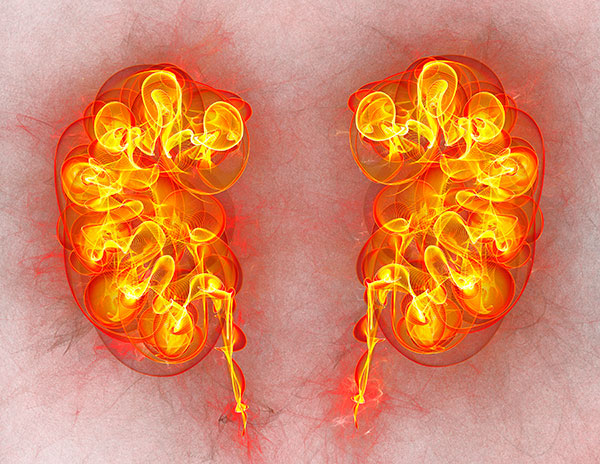Scientists at the University of California San Francisco (UCSF) are working on a new approach to treating kidney failure that could one day free people from needing dialysis or taking drugs to suppress their immune system after a transplant. The preclinical study showed, for the first time, the investigators claim, that human renal epithelial cells (HRECs) housed in an implantable bioreactor can survive in a pig’s body and mimic several important kidney functions, without the need for systemic immunosuppression.
The results represent an important achievement for The Kidney Project, which is jointly headed by UCSF’s Shuvo Roy, PhD (technical director) and Vanderbilt University Medical Center’s William H. Fissell, MD (medical director). The reported study focused on demonstrating proof of concept for a bioreactor component of a future implantable bioartificial kidney (iBAK), which contains silicon nanopore membranes (SNPs) to protect the cells from immune rejection. The ultimate aim is to fill the bioreactor with different kidney cells that perform vital functions like balancing the body’s fluids and releasing hormones to regulate blood pressure—then pair it with a hemofilter device that filters waste from the blood.
“We are focused on safely replicating the key functions of a kidney,” said Roy, a bioengineering professor in the UCSF School of Pharmacy. “The bioartificial kidney will make treatment for kidney disease more effective and also much more tolerable and comfortable.”
Roy, Fissell and colleagues reported on their development in Nature Communications, in a paper titled “Feasibility of an implantable bioreactor for renal cell therapy using silicon nanopore membranes.” In their paper the researchers concluded, “We present the initial steps toward developing an iBAK that will include a cell-containing bioreactor component to recapitulate native renal tubule function … Specifically, in this pilot study, we demonstrate the feasibility of a bioreactor that utilizes SNM to potentially immunoprotect against hyperacute rejection and sustain HREC in vitro and in vivo.
More than two million people worldwide receive treatment for end-stage renal disease (ESRD), the incidence of which is on the rise as rates of diabetes and hypertension increase, the authors noted. More than 500,000 people in the U.S. require dialysis several times a week, and while kidney transplantation offers can offer “excellent outcomes,” with a five-year survival of >80% for recipients of living donor organ, there are not enough donors. Only about 20,000 people receive a transplant each year. Moreover, the lifelong immunosuppression needed by transplant recipients can cause serious health problems, while the potential for graft rejection is also a constant concern.
The Kidney Project aims to creating a bioartificial kidney as a permanent solution to kidney failure. For their reported study Roy and colleagues engineered a bioreactor to connect directly to blood vessels and veins, allowing the passage of nutrients and oxygen, much like a transplanted kidney would. The bioreactor comprises silicon nanopore membranes (SNMs) that keep the kidney cells inside safe from attack by the recipient’s immune cells. “These silicon nanopore membranes are uniquely suited to serve as an exclusion barrier due to their high molecular selectivity,” the scientists noted.
For their test case the researchers used a type of kidney cell called a proximal tubule cell, which regulates water. Co-author H. David Humes, MD, from the University of Michigan, had previously used these cells to help dialysis patients in the intensive care unit with life-saving results. “Here, we focus on the bioreactor component of the iBAK and describe the first steps in the development of an implantable device to replicate key functions of the renal tubule, which is intended to ultimately function in tandem with an implantable hemofilter,” the researchers wrote.
“… we report a proof-of-concept implantable bioreactor containing silicon nanopore membranes to offer a level of immunoprotection to human renal epithelial cells.”
The team tracked the kidney cells and the recipient animals for seven days after transplantation, that both did well. “We assembled and implanted SNM-containing bioreactor prototypes and confirmed their patency for up to seven days in pigs that only received antiplatelet agents. Additionally, the bioreactors supported encapsulated xenogeneic HREC in the immunocompetent pigs without the administration of systemic immunosuppression,” the investigators stated. The team did note that the experimental design was optimized to study cell viability, rather than transport or metabolic function. Nevertheless, they wrote, “… we report a proof-of-concept implantable bioreactor containing silicon nanopore membranes to offer a level of immunoprotection to human renal epithelial cells.”
The next step will be month-long trials in animals, with trials eventually in humans. “We needed to prove that a functional bioreactor will not require immunosuppressant drugs, and we did,” Roy said. “We had no complications and can now iterate up, reaching for the whole panel of kidney functions at the human scale.”
“… we demonstrated the feasibility of a bioreactor with promising features, such as a potential lack of need for immunosuppression or systemic anticoagulation, with no consequence to cell viability or function,” the researchers concluded. “Future efforts will focus on increasing both cell numbers and implantation periods with an increased number of animals to establish statistical significance and definitive proof.”



